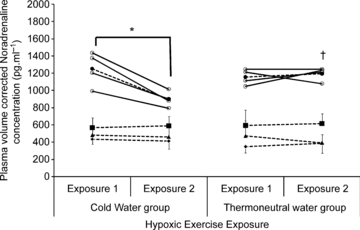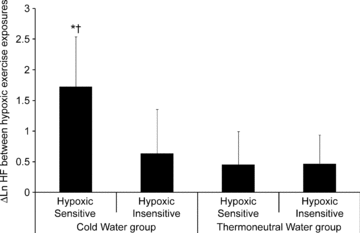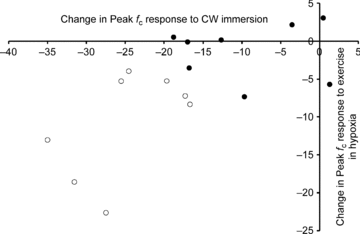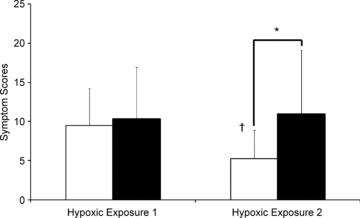'Cross-adaptation': habituation to short repeated cold-water immersions affects the response to acute hypoxia in humans
- PMID: 20643773
- PMCID: PMC2988521
- DOI: 10.1113/jphysiol.2010.193458
'Cross-adaptation': habituation to short repeated cold-water immersions affects the response to acute hypoxia in humans
Abstract
Adaptation to an environmental stressor is usually studied in isolation, yet these stressors are often encountered in combination in the field, an example being cold and hypoxia at altitude. There has been a paucity of research in this area, although work with rodents indicates that habituation to repeated short cold exposures has a cross-adaptive effect during hypoxia. The present study tested the hypothesis that cross-adaptation is also possible with humans. Thirty-two male volunteers were exposed to 10 min bouts of normoxic and hypoxic (FIO2 0.12) rest and exercise (100 W on a recumbent cycle ergometer). These were repeated after a 96 h interval, during which participants completed six, 5 min immersions in either cold (12°C, CW) or thermoneutral water (35°C, TW). Venous blood samples were taken immediately after each bout, for determination of catecholamine concentrations. A three-lead ECG was recorded throughout and the final 5 min of each bout was analysed for heart rate variability using fast fourier transformations (and displayed as log transformed data (ln)). In comparison with the first hypoxic exercise exposure, the second exposure of the CW group resulted in an increased ln high frequency (ln HF) power (P < 0.001) and reduced adrenaline (P < 0.001) and noradrenaline concentrations (P < 0.001). Adrenaline and noradrenaline concentrations were lower in the CW group during the second hypoxic exercise compared to the TW group (P = 0.042 and P = 0.003), but ln HF was not. When separated into hypoxic sensitive and hypoxic insensitive subgroups, ln HF was higher in the hypoxic sensitive CW group during the second hypoxic exercise than in any of the other subgroups. Cold habituation reduced the sympathetic response (indicated by the reduced catecholamine concentrations) and elevated the parasympathetic activity (increased ln HF power) to hypoxic exercise. These data suggest a generic autonomic cross-adaptive effect between cold habituation and exposure to acute hypoxia in humans.
Figures






References
-
- Akselrod S, Gordon D, Ubel F, Shannon D, Berger A, Cohen R. Power spectrum analysis of heart rate fluctuations: a quantitative probe of beat-to-beat cardiovascular control. Science. 1981;213:220–222. - PubMed
-
- Altland P, Highman B, Dieter M. Reduced hypoxic tolerance of cold-acclimated rats: serum enzyme and tissue changes. Am J Physiol. 1972;222:1441–1445. - PubMed
-
- Altland PD, Highman B, Sellner RG. Tolerance of cold – acclimated and unacclimated rats to hypoxia at 1.7°C. Int J Biometerol. 1973;17:59–71. - PubMed
-
- Bernardi L, Passino C, Wilmerding V, Dallam G, Parker D, Robergs R, Appenzeller O. Breathing patterns and cardiovascular autonomic modulation during hypoxia induced by simulated altitude. J Hypertens. 2001;19:947–958. - PubMed
-
- Berntson G, Bigger T, Eckberg DL, Grossman P, Kaufmann P, Malik M, Nagaraja H, Porges S, Saul P, Stone P, Van Der Molen M. Heart rate variability: origins, methods and interpretive caveats. Psychophysiology. 1997;34:623–648. - PubMed
Publication types
MeSH terms
LinkOut - more resources
Full Text Sources
Research Materials
Miscellaneous

